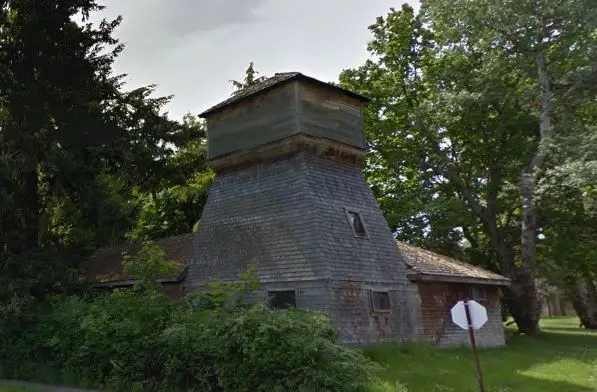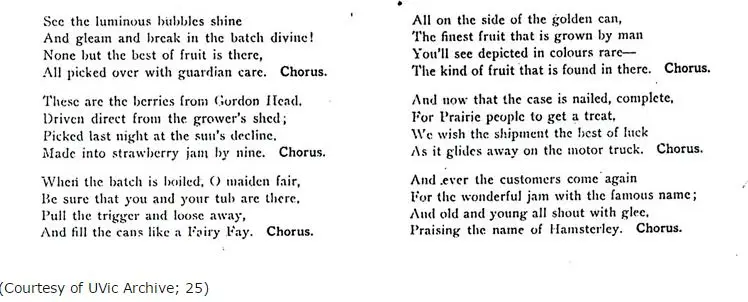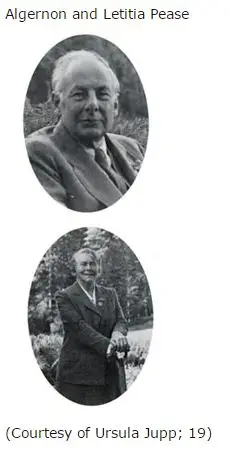
source: Canada’s Historic Places
Hamsterley Farm Water Tower
2485 Sinclair Road, Saanich, British Columbia, V8P, Canada
Formally Recognized: 1997/11/03
OTHER NAME(S)
Hamsterley Farm Water Tower
Tower of Jam
Drummadoon
The Pease Jam Factory
CONSTRUCTION DATE(S)
1911/01/01 to 1916/01/01
DESCRIPTION OF HISTORIC PLACE
The Hamsterley Farm Water Tower is a shingle-sided, wood-frame building with an L-shaped plan. At the junction of the arms is the supporting tower, which once carried the water tank, topped with cladding of rough weatherboard. It is located in the Cadboro Bay area of Saanich.
HERITAGE VALUE
The Hamsterley Farm Water Tower is a valuable reminder of the importance of market gardening in Saanich. Built initially to store well water to supply the house of Algernon Henry (Lloyd was his 1st half cousin) and Letitia Jean Pease (nee Brydges), it is also a reminder of the necessity for individuals to provide their own supply of domestic water in the early years of the twentieth century. With the success of the farm’s crop of strawberries the family went into jam production, making the locally popular Hamsterley Farm Strawberry Jam. Strawberries flourished in Saanich and are an important local food product; a Strawberry Festival is still held annually in mid-July.
The water tower is important for its connection with the Pease family. Algernon Henry and Letitia Pease were entrepreneurs, and in addition to their successful jam-making enterprise they made chocolates and candy, owned a chicken farm, made home-made wine, which he marketed during Prohibition, operated tea-rooms, and speculated in land. Algernon was appointed an M.B.E. for his work in establishing the B.C. Salvage Corps in the Second World War. During the War, Letitia Pease was instrumental in starting “Bundles for Britain”, which sent new and used clothing to those who had been bombed out in Britain. She also opened the Superfluities Shop, on Government Street in Victoria, where donations of valuables, to be sold for the war effort, were accepted.
This structure is associated with the architect Percy Leonard James (1878-1970), who designed both it and the farmhouse. James had a long and prolific career that demonstrated a versatile talent for design.
From 1933 to 1946, the property was also notable for its then owner, Alice Maud Robertson, who owned Victoria’s famous “The Spode Shop”. She called her property “Drummadoon.” She and her daughter, Margo, were horsewomen, and they had the tower enclosed as a stable, with hayloft and tackroom in the tank section.
Source: Heritage Planning Files, District of Saanich
CHARACTER-DEFINING ELEMENTS
Key elements that define the heritage character of the Hamsterley Farm Water Tower include its:
– location at the junction of Haro and Sinclair Roads
– form, scale and massing of the tower and connected wings
– cedar shingle cladding the entire complex up to the level of the second storey
– weatherboard articulating the location of the water tank.
source: UVic Web Mapping
The Hamsterley Jam Factory and the Strawberry Years
This above structure was built in approximately 1911, at the corner of Haro and Sinclair roads, by a man named Algernon Pease Algernon Pease came to Canada in 1907, married Letitia Jean Brydges from Nova Scotia, and they both moved to Victoria. Algernon and his wife purchased 10 acres of land at the top of Sinclair Road where they dug a well, built a large house, constructed a water tower, and started to farm.
Like many other farming endeavours in this region at the turn of the century, Algernon and Letitia’s farm was very diverse – a mixed market garden.
To start his farming, Algernon purchased cows, pigs, plough horses and thousands of chickens. He also established a large garden to grow a mix of vegetables, fruit and flowers. By 1914, Algernon and Letitia acquired a stall at the Public Market. Their flowers and produce sold very well and the Pease family decided to plant more tomatoes and strawberries, produce butter and cream, and dress rabbits and chickens for the market.
Many farmers in Gordon Head were planting and harvesting strawberries. On the Pease farm, people worked in fields in the area that is, today, the northwest portion of the university campus; the area that includes the Student Union Building, Student Housing, and the Buildings and Grounds. The richness of the soil in this area is indicated by the large size of the berries – it was often difficult for pickers to get the required number of strawberries into their baskets.
With a surplus of fruit, Algernon and Letitia were inspired to make jam. The tower that once served as a water tower was converted into the family jam factory. During their first year of production, one thousand cases of jam were made and sold. Algernon wrote a song about the jam factory and the strawberries.
Hamsterley Jam Factory Song: The original sheet music can be found at the end of the page. Please see below for sound recording.
The Hamsterley Farm Jam Song was written and composed by Algernon Pease in 1916 to promote the sale of their jam product. The song demonstrates Algernon’s relationship with the landscape, social interactions involved in jam production, and the care and delight that was taken to produce the product.
Llisten to a version of the Hamsterley Jam Factory Song recorded by Melissa and friends

To manage the whole farm and to pick all the strawberries during harvest time, paid help was needed. Girls and boys that had graduated high school or attended university in Vancouver came over to Victoria on the CPR boat for the summer to pick berries. Strawberry picking brought people together and was a social activity across the landscape. They wore overalls to pick berries, lived in A-frame tents, slept on straw mattresses, washed in tin basins, and swam down in Cadboro Bay. During the World War I, women became increasingly involved with working in agriculture to help the war efforts and they remained a part of the strawberry and farming industry after the war.

Algernon and Letitia Pease (Courtesy of Ursula Jupp; 19)
In Cadboro Bay, some people still remember the Pease family, their stories, efforts and personalities.
Ethnoecological Significance:
People have moved across the landscape in different ways, on a daily, seasonal and yearly basis. Algernon and Letitia dwelled within their landscape, engaging with the land, engaging with nature, maintaining social connections, and staying actively involved in their community. Their jam factory song tells a story and shares their love; it demonstrates how they lived in and respected their environment. Not only did the Pease family become fully engaged with and aware of their surrounding, but they also provided an opportunity for others to engage with the land and with each other too.
The water tower that the Pease built is an important reminder of the value and significance of market gardening in Gordon Head’s early days of pioneer development. The importance and value of strawberries and mixed farming influenced social interactions and placed a story on the landscape. Through examining past agricultural practices we can learn more about past landscapes and our agricultural practices today.
To carry on the story of Saanich agriculture and the valuable strawberry harvests of the past, an annual Strawberry Festival is held within the region in July. In 2009, the Annual Saanich Strawberry Festival will be celebrating its 43rd successful year.
3815 Haro Road (ca. 1911) Saanich
This water tower is one of the last remaining in the municipality. Until the Saanich Waterworks reached rural areas, many framers had water tanks in towers. This one was reportedly designed by architect Percy Leonard james, along with the Peases’ house (part of which was moved and serves as the University of Victoria’s Student Health Services Centre). The tower was originally a tank on a raised platform. In 1933 it was enclosed as a stable, with hayloft and tackroom in the tank section. Windows were added, it was shingled, given a shake roof, and the tank portion was covered in rough weatherboards.
The Peases named their property “Hamsterley Farm” and operated a strawberry jam factory on it. After they sold it, they opened the “Hamsterley Tea Room” on the Malahat, then “Hamsterley Lakeside” and later the “Toby Jug” at Elk Lake. From 1933 to 1946 the property was owned by Alice Maud (Mrs. Fred) Robertson of “The Spode Shop”. She called the property “Drummadoon,” and it became “Upper Drummadoon” when her daughter’s house, “Lower Drummadoon,” was built lower down the hill.
One Response
This is awesome! I met Mrs. Pease when she was a very elderly lady; The Peases were parents of my Mom’s friend Rosalind. Her son Doug ( Campbell ) and I are friends still. I wish I could have seen the farm, and attended some of the social events at the Hamsterley Tea Room. : O )